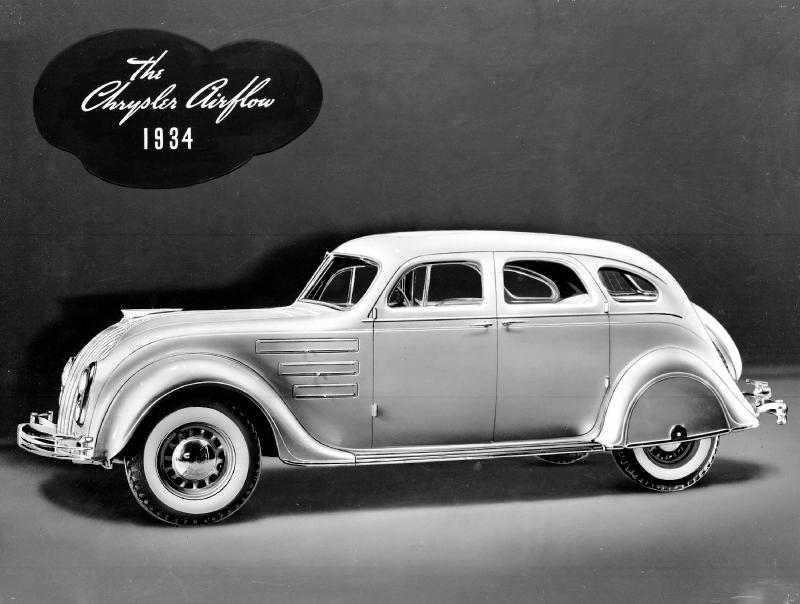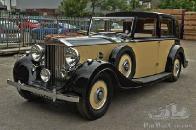Let Jay Leno Tell You Why the 1934 Chrysler Airflow Was So Revolutionary
By: MÁTÉ PETRÁNY (TheDrive)
BUZZ NOTE: There is a youtube video at the end of this article that I believe is of Jay Leno talking about the Chrysler Airflow car which can be accessed by clicking on the SEEDED CONTENT link just below this message which will open the original source article.

Let Jay Leno Tell You Why the 1934 Chrysler Airflow Was So Revolutionary
Meet America's first aerodynamic car.

www.thedrive.com
If there’s one car Jay Leno often mentions in his garage videos, it’s his 1934 Chrysler Airflow. This now-rare luxury car was once a very forward-thinking, misunderstood engineering experiment, which the aging Walter Chrysler’s team just couldn’t manage to sell in large enough numbers, eventually calling it a commercial failure.
It was eventually toned down in styling after 1934 but was finally phased out after 1937. Less than 30,000 units left the Highland Park assembly line before Chrysler would move on to a much more conventional design for 1938.
Jay Leno’s pride and joy, a first-year Chrysler Airflow Imperial CX is a LeBaron-bodied six-seater built on a 137.5-inch wheelbase, and one of the only three surviving CXs today. Perhaps inspired by Europe’s Tatras and designed in a brand-new wind tunnel using aviator pioneer Orville Wright’s know-how, the Airflow became America’s first streamlined car full of clever comfort features and Art Deco touches.

FCA
Tatra (and Zeppelin) designer Paul Jaray actually sued Chrysler claiming the Airflow was a copycat. However, Tatras were rear-engined cars with air-cooled V8s, Chrysler’s aerodynamic tourer featured a straight-eight flathead mounted way forward over the front axle. This reliable cast-iron engine produced 122 horsepower and 250 pound-feet of torque for a top speed just over 100 mph, and was quite and comfortable cruising at up to 80 mph thanks to a three-speed transmission with overdrive and freewheeling.
Behind the controversial waterfall grille, Chrysler added more venting points than any of its competitors, making sure the air could really flow through this car at any given speed. The 1934 Airflow debuted with triple adjustable air slats behind its fenders, two just in front of the windshield channeling air to your feet, a split-windshield that also cranks open, side glass that disappears into the doors with the vent windows included, plus two more vent windows on the C-pillars.
With no side mirrors in sight, the Airflow was advertised to be a 20 mpg luxury car, which Chrysler added that “the water actually runs up through the windshield during a rainstorm, while no dust collects on its back.”
That’s great news because Jay Leno’s is such a California car, that it’s missing both of its individually activated wipers.
No politics, no religion, no instagrams, and commentary must be civil. The ToS and the CoC will be enforced, and anything that the administrator deems to be offensive will be deleted. YouTubes, videos and images that the administrator is unable to open must be described and explained or they will be deleted.








Although I never owned a Chrysler, DeSoto, Dodge or Plymouth vehicle my father owned a 1948 Chrysler Windsor that had a speedometer that would change colour from green, to amber to red depending on the car speed. I thought that was a great idea and I'm surprised the concept wasn't used more universally.
One of the most influential designs ever. I don't think that after nearly a century of aerodynamics, we today can imagine how "different" it was.
You used the word "different" and it made me think of the time when car designs were such that they appeared different from each other and it was easy to identify what brand they were. I recall that when I was a young kid spending the summer vacation at my grandmother's summer cottage that was close to the Queen Elizabeth Way, a highway that ran from Toronto to Niagara Falls running along the Burlington Beach strip of land at the far western tip of Lake Ontario, a friend and I used to sit by the highway competing to see who could first name the brands of the cars as they went by. We could never do that today, because they all look alike, like turtles or clam shells for aerodynamic reasons.
Aerodynamics are a bitch.
Yet in some cases a benefit and in others a necessity.
Some cars now have a CD around .25. I remember not so long ago when "under .3" was outstanding.
I'll bet my father's 1952 Hudson Hornet had a pretty good rating back then.
The train is the Union Pacific's M-10000. the second streamlined train powered by internal combustion engine . Different and aerodynamic like the Airflow
Thanks for the info.
Why did I know you would comment about the train? LOL I knew it as soon as I saw that picture.
Trains and Chrysler products are two things I like
Did you ever travel on a high-speed train, one that can go 350 kilometres per hour? They all run on elevated tracks as in the picture - no way can they hit a vehicle stuck at a crossing or a cow that strays off its field nor can a kid get access to a track to put a coin on it to flatten like I did with pennies when I was a kid.
I've been on them four times, once between Suzhou and Shanghai, twice between Zhengzhou and Kaifeng and once between Chengdu and Chongqing. Each ride was for no more than an hour or so and it felt like being in an airplane, for the silence and smooth ride and even to the extent of getting a free bottle of water.
I've been riding high speed trains for going on forty years.
Of course, in Europe, but America is "highway country" and the rail system is way way behind other nations.
For Most of US passenger speed is 79. Acalas can go 150 on parts of Northeast Corridor. Brightline in Florida can go 125 in places and Amtrak has some 90 and 110 places I read about plans for improvements. US passenger rail service has declined a lot.
In 1950s Norfolk & Western made a movie about their passenger trains showing a steam locomotive speedometer at a steady 105. That is an example and other railroads back then ran faster.
Travelling at almost 220 mph on land is quite exhilarating
I absolutely love train travel (outside the US). They're just so much more comfortable than any other means of travel.
Fastest I've ever gone was on the TGV between Dijon and Paris. 204 mph.
Totally off topic (even trains are but I'm happy about that) is that I'm having trouble getting Dijon mustard here, and I'm stuck with that usual yellow French brand mustard thing.
I've been riding 200 mph trains for almost forty years.